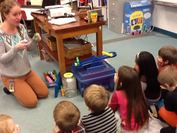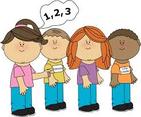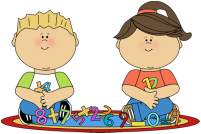|
You can learn about what mathematical ideas your child is working on by exploring the resources found in each of the nine weeks below. You will find video clips, examples of student work, and games/activities to try at home!
Kindergarten Unpacking Document Major Work Standards Counting is More Than One Two Three Videos of Kindergarten Discussions Kindergarten Parent Information from NCDPI |
|
First Quarter

During the first nine weeks, your Kindergartner will be learning to count. Counting involves more than just reciting the rote sequence of numbers. Your child will be developing cardinality, ideas about quantity and attaching symbols and words to those quantities. Ten frames and dot images are some of the ways that students begin to internalize quantities. Your child will begin comparing numbers and learning the symbols for the number names.
Video of students counting: Video 1 Assessing Counting Video 2 Counting Jar Dot Images 3 to 4 Dots 5 Dots Five and Ten Frames Five Frame Game How to Use a Ten Frame Ten Frames Count with your child with these counting videos: Counting to 5 Counting to 10 Counting to 20 Books to Read Ten Black Dots Student Work Samples 
Third Quarter
During the third nine weeks, your Kindergartner will continuing work with geometric ideas. Students will learn to identify, describe and name 3 dimensional shapes. They will connect the shapes to objects in the environment and engage in looking at the parts of the objects. Students identify objects as flat (2 dimensional) or solid (3 dimensional). As the teacher embeds the vocabulary into students’ exploration of various shapes, students use the terms two-dimensional and three-dimensional as they discuss the properties of various shapes. Students also use positional words (such as above, below and next to) to describe objects in the environment, developing their spatial reasoning competencies. At home, you can ask students to place objects in different positions. Or place objects on a table and ask students to describe where the objects are. Counting, joining and separating ideas will continue during this quarter. Students will be counting sets of objects up to 20 objects; decomposing numbers to 10 in a variety of ways; using numbers and notation Note: Kindergarten students should see equations (3 + 2 = 5) and may write them but it is not required. The focus is on understanding the operations of addition and subtraction not on reading and solving of equations. |
|

Second Quarter During the second nine weeks, your Kindergartner will be extending the counting sequence. There will be a focus on using multiple non standard units to measure length, counting sets of objects and finding the total after an amount is added or taken away. The following four problem types in the chart below will be addressed.Your child will also be developing ideas about 2-D shapes and their attributes and the relationship between them as well as ways to decompose and compose them, describe and name them. There will also be a focus on learning how describe the relative position of objects using words such as below, above, and next to. Videos of Students Joining and Separating Amounts: Video 1 How Many of Each? (Second Clip on page) Video 2 Quick Images Video 3 The Rekenrek ( Arithmetic Rack) Books to Read Domino Addition The Book of Shapes Mouse Shapes Games To Play Student Work Samples 
Fourth Quarter
In the last semester of Kindergarten, your child will continue working on developing strategies for adding and subtracting small amounts. Students will refine their counting strategies and be able to count objects in a variety of arrangements ( circles, arrays, lines and scattered). Kindergarten students will participate in a variety of activities to build fluency within 5 and to be able to decompose numbers up to 10. They will use ten frames and games to decompose numbers 11 to 19 into a group of ten ones and some leftover ones. During this quarter, your child will also develop ideas about counting; sorting, classifying and ordering data and using data to solve problems. |


